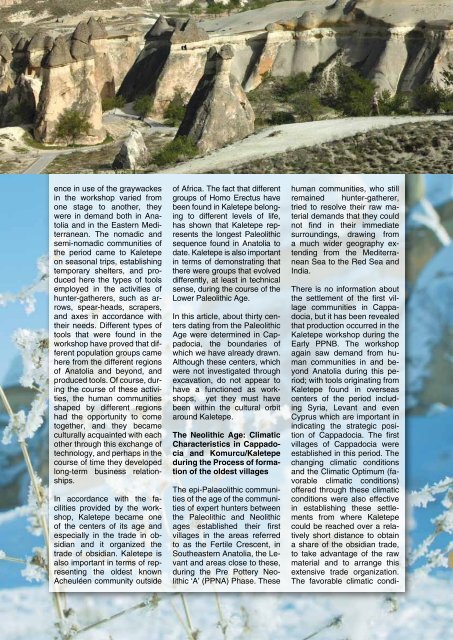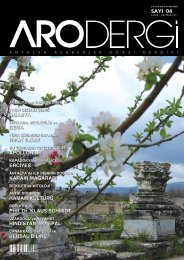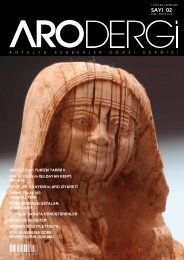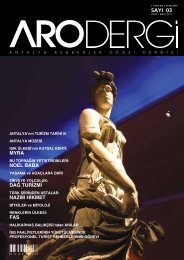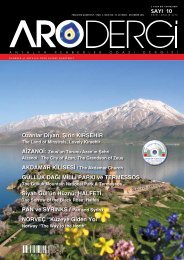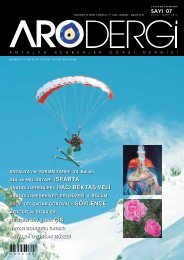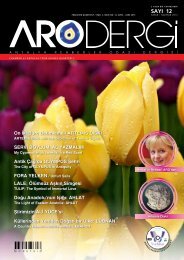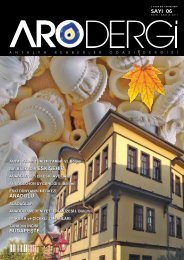Doğu Akdeniz gibi Anadoludışından talepler görmüştür.Dönemin göçebe ve yarı göçebetoplulukları mevsimlik seyahatlerleKaletepe’ye gelmişler,geçici barınaklar kurmuşlar veihtiyaçları doğrultusunda avcılıkve toplayıcılık faaliyetlerineyönelik ok, mızrak ucu, kazıyıcı,balta gibi alet tiplerini buradaüretmişlerdir. Atölye’de bulunanbirbirinden değişik alettipleri, buraya Anadolu’nunfarklı bölgelerinden ve Anadoludışından değişik halk gruplarınıngeldiğini ve alet ürettikleriniispatlamıştır. Elbettebu üretim faaliyetleri sırasındafarklı bölgelerin şekillendirdiğiinsan toplulukları bir araya gelmefırsatı bulmuş, birbirlerindenteknoloji takasıyla kültüreltanışıklık olmuş, belki de uzunvadede bir ticari ilişki geliştirmişlerdir.Atölyenin sağladığı imkanlardoğrultusunda Kaletepe, çağının,özellikle de obsidyen ticaretininmerkezlerinden birinioluşturmuş, obsidyen ticaretiniorganize etmiştir. Kaletepe,aynı zamanda Afrika dışındakien eski Acheuléen topluluğunutemsil etmesi bakımından daönemlidir. Kaletepe’de farklı yaşamdüzeylerine ait farklı HomoErectus gruplarının bulunmuşolması, Anadolu’nun, şimdilik,en uzun Paleolitik sekansınıtemsil ettiğini göstermiştir. Kaletepe,ayrıca Alt Paleolitik’teen azından teknik anlamdafarklı evrimleşmiş grupların varolduğunu da ortaya koymasıbakımından önemlidir.Bu yazıda sınırlarını çizdiğimizKapadokya’da Paleolitik Çağ’ailişkin otuza yakın merkezsaptanmıştır. Kazı yöntemiylearaştırılmayan bu merkezler,şimdilik, atölye işlevi görünümüarz etmese de, Kaletepeetrafında şekillenen kültürelçerçevenin içinde yer alıyor olmalıdırlar.Neolitik Çağ: Kapadokya’daİklimsel Özellikler ve En EskiKöylerin Oluşum SürecindeKömürcü / KaletepePaleolitik ile Neolitik arasındauzman avcı toplulukları çağınınEpipaleolitik toplulukları,ilk köylerini Bereketli Hilal olarakifade edilen coğrafyada,“Çanak Çömleksiz Neolitik ‘A’Evresi”nde (PPNA: Pre PotteryNeolithic ‘A’) GüneydoğuAnadolu ve Levant ile bu hattınyakın bölgelerinde kalanalanlarda kurmuşlardır. Halaavcı-toplayıcı olan insan toplulukları,yakın çevrelerinde bulamadıklarıhammadde talepleriniAkdeniz’den Kızıldeniz’eve Hindistan’a dek geniş bircoğrafyadan gidermeye çalışmışlardır.İlk köy topluluklarının Kapadokya’dayerleştiklerine ilişkinbilgi yoktur; ancak Kaletepeatölyesinde Erken PPNB’deüretim yapıldığı ortaya konmuştur.Atölye, yine bu dönemdeAnadolu ve Anadolu dışındakiinsan topluluklarından rağbetgörmüştür; Suriye, Levantve hatta Kıbrıs gibi dönemindenizaşırı sayılabilecek merkezlerindebulunan Kaletepekökenli aletler, Kapadokya’nınstratejik konumunu göstermesibakımından önemlidir. Budönemde Kapadokya’nın ilkköyleri kurulmuştur. Obsidyenticaretinden pay almak, hammaddedenfaydalanmak ve bubüyük organizasyonu düzenlemekiçin Kaletepe’ye kısamesafede ulaşılabilen bu yerleşimlerinkurulmasında, değişeniklim şartları ve bu iklimşartlarının sunduğu ClimaticOptimum da (uygun iklim koşulları)etkili olmuştur. Gümümüzden10 bin yıl önce başlayıp7. bin yılın ortalarına dekdevam eden elverişli iklim koşullarınınvarlığı, Acıgöl polenanalizlerinden anlaşılmıştır.Bu süreçte ılıman yaz aylarınaözgün orman çeşitliliği arttığı,fakat aynı zamanda kışlarındaha sert geçtiğini ispatlayankozalaklı ağaçların da koşutoranda çoğaldığı anlaşılmıştır.Oluşan mevsim döngüsü bitkiçeşitliliğini arttırmış, bu çeşitlilikhayvan varlığını da olumluetkilemiştir.Kapadokya’nın En EskiKöyü: Aşıklı HöyükKapadokya’nın en iyi araştırılanen eski köyü, Aksaray/Gülağaç ilçesine bağlı Kızılkayaköyü yakınındaki, Me-40>41 ANTALYA REHBERLER ODASI DERGİSİ
ence in use of the graywackesin the workshop varied fromone stage to another, theywere in demand both in Anatoliaand in the Eastern Mediterranean.The nomadic andsemi-nomadic communities ofthe period came to Kaletepeon seasonal trips, establishingtemporary shelters, and producedhere the types of toolsemployed in the activities ofhunter-gatherers, such as arrows,spear-heads, scrapers,and axes in accordance withtheir needs. Different types oftools that were found in theworkshop have proved that differentpopulation groups camehere from the different regionsof Anatolia and beyond, andproduced tools. Of course, duringthe course of these activities,the human communitiesshaped by different regionshad the opportunity to cometogether, and they becameculturally acquainted with eachother through this exchange oftechnology, and perhaps in thecourse of time they developedlong-term business relationships.In accordance with the facilitiesprovided by the workshop,Kaletepe became oneof the centers of its age andespecially in the trade in obsidianand it organized thetrade of obsidian. Kaletepe isalso important in terms of representingthe oldest knownAcheuléen community outsideof Africa. The fact that differentgroups of Homo Erectus havebeen found in Kaletepe belongingto different levels of life,has shown that Kaletepe representsthe longest Paleolithicsequence found in Anatolia todate. Kaletepe is also importantin terms of demonstrating thatthere were groups that evolveddifferently, at least in technicalsense, during the course of theLower Paleolithic Age.In this article, about thirty centersdating from the PaleolithicAge were determined in Cappadocia,the boundaries ofwhich we have already drawn.Although these centers, whichwere not investigated throughexcavation, do not appear tohave a functioned as workshops,yet they must havebeen within the cultural orbitaround Kaletepe.The Neolithic Age: ClimaticCharacteristics in Cappadociaand Komurcu/Kaletepeduring the Process of formationof the oldest villagesThe epi-Palaeolithic communitiesof the age of the communitiesof expert hunters betweenthe Paleolithic and Neolithicages established their firstvillages in the areas referredto as the Fertile Crescent, inSoutheastern Anatolia, the Levantand areas close to these,during the Pre Pottery Neolithic‘A’ (PPNA) Phase. Thesehuman communities, who stillremained hunter-gatherer,tried to resolve their raw materialdemands that they couldnot find in their immediatesurroundings, drawing froma much wider geography extendingfrom the MediterraneanSea to the Red Sea andIndia.There is no information aboutthe settlement of the first villagecommunities in Cappadocia,but it has been revealedthat production occurred in theKaletepe workshop during theEarly PPNB. The workshopagain saw demand from humancommunities in and beyondAnatolia during this period;with tools originating fromKaletepe found in overseascenters of the period includingSyria, Levant and evenCyprus which are important inindicating the strategic positionof Cappadocia. The firstvillages of Cappadocia wereestablished in this period. Thechanging climatic conditionsand the Climatic Optimum (favorableclimatic conditions)offered through these climaticconditions were also effectivein establishing these settlementsfrom where Kaletepecould be reached over a relativelyshort distance to obtaina share of the obsidian trade,to take advantage of the rawmaterial and to arrange thisextensive trade organization.The favorable climatic condi-
- Page 1 and 2: PUBLISHED QUARTERLY, YEAR: 3, ISSUE
- Page 3 and 4: Yeni Yıl, Yeni Bakan24 Ocak’ta
- Page 5 and 6: Merhaba Sevgili Okurlar,Acısıyla,
- Page 7 and 8: A Hidden City in Cilicia:The ANCIEN
- Page 9 and 10: used in the construction of thissma
- Page 11 and 12: Zengin içecek çeþitleri,Damak ta
- Page 13 and 14: ehind and move on for about500 m.,
- Page 16 and 17: Yüz Yıllık Destan: Hamidiye Kruv
- Page 18 and 19: Hamidiye Kruvazörü ve Hüseyin Ra
- Page 20 and 21: Hamidiye Kruvazörü ve Hüseyin Ra
- Page 22 and 23: Hamidiye Kruvazörü ve Hüseyin Ra
- Page 24 and 25: Hamidiye Kruvazörü ve Hüseyin Ra
- Page 26 and 27: Hamidiye Kruvazörü ve Hüseyin Ra
- Page 28: Hamidiye Kruvazörü ve Hüseyin Ra
- Page 31 and 32: HÜSEYİN RAUF ORBAYOsmanlı İmpar
- Page 33 and 34: Yýllýk olarak tahmini uluslararas
- Page 35 and 36: www.adnansayki.comBOSPHORUS LARASey
- Page 38 and 39: Kapadokya’nınTarih ÖncesiYrd. D
- Page 42 and 43: Kapadokya’nın Tarih Öncesi / Th
- Page 44 and 45: Kapadokya’nın Tarih Öncesi / Th
- Page 46: Kapadokya’nın Tarih Öncesi / Th
- Page 49 and 50: were found in the settlementof Guve
- Page 51 and 52: the Early Bronze Age, is calledCapp
- Page 53 and 54: Those Who Give Sound to the Earth,T
- Page 55 and 56: M. Emin Bolat was born in Iskenderu
- Page 57 and 58: “Kapadokya”DERVÝÞ EVÝGöreme
- Page 59 and 60: Our Thracian Countryman: ORPHEUSSul
- Page 61 and 62: lyre that the wild animalswould get
- Page 63 and 64: Persephone and of Orpheus’Eurydic
- Page 65 and 66: CANKURTARANHALIHayatDokundukçaGüz
- Page 67 and 68: The DoradoAtilla Sukru NILGUN, Tour
- Page 69 and 70: land of Malta. The largest catchesc
- Page 71 and 72: Dostlarla Bir MolaCAFE MOLABon Appe
- Page 73 and 74: dolu’yu, Doğu Akdeniz kıyılar
- Page 75 and 76: Aizanoi: The City of Azan,The Grand
- Page 77 and 78: the corridors of the bath andhere,
- Page 79 and 80: Türk mutfaðýnýn yöresel yemekl
- Page 81 and 82: with columns. Three gatesopening to
- Page 83 and 84: pecially during the Romanperiod due
- Page 85 and 86: GRAFÝK TASARIM - WEB TASARIM - ARA
- Page 87 and 88: pedestrians.It is written on the in
- Page 89 and 90: logical Museum of Kutahya,and see t
- Page 91 and 92:
Aspendos - Part 4T. M. P. DUGGANDue
- Page 93 and 94:
was employed in the design ofthis e
- Page 96 and 97:
AspendosFotoğraf: Halil Arıkanbun
- Page 98 and 99:
Aspendostürülmesinin muhtemelen12
- Page 100 and 101:
Dubai:Ortadoğu’nun Parlayan Yıl
- Page 102 and 103:
Dubai: Ortadoğu’nun Parlayan Yı
- Page 104:
Dubai: Ortadoğu’nun Parlayan Yı
- Page 107 and 108:
Dubai, gece görünüm / Night View
- Page 109 and 110:
2012 Yılı Seminerlerini Tamamlad
- Page 111 and 112:
ARO Eğitim GezileriDöşemealtı v
- Page 113 and 114:
ARO Söyleşileri Devam Ediyor...08
- Page 115 and 116:
Basında ARO
- Page 117 and 118:
ARO EtkinlikleriÜyelerimize Yönel
- Page 119 and 120:
SANCAKTAROÐLUSÝGORTA“Keþke”
- Page 121 and 122:
Yukarıdan Aşağıya:1. Ağaç dir
- Page 123 and 124:
Hastalýkta saðlýkta...Tel: +90 3


